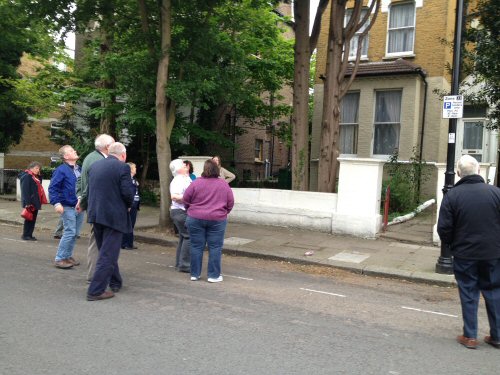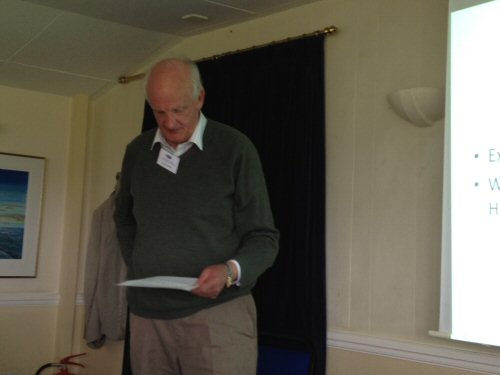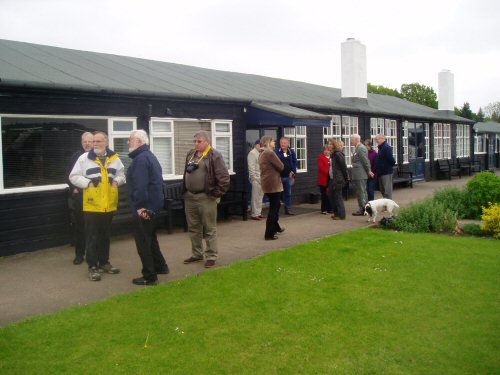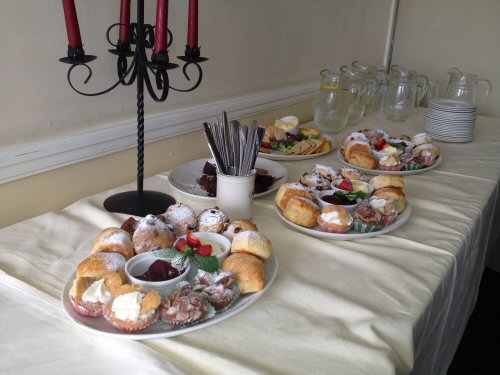A report by Alison Jenner
White Waltham Weekend
19th - 20th May, 2012.
Around twenty Shutists, including three Americans and a Dutchman, met at the Holiday Inn, Maidenhead, where the summer sunshine gave us an appropriate holiday atmosphere. We made our introductions, and formed up into carfuls of careful travellers travelling east into London. We knew from the news that the Queen was due to preside over a Jubilee celebration at Windsor; a party including two overseas visitors, craned necks to be sure of spotting the Castle as they sped east down the M4. Imagine their pleasure when a flight of jets in perfect formation crossed high above the motorway; just think of the joy when, a short while later, the royal Rolls, outriders on station, passed going westwards. Laura Schneider is convinced HMQ was inside, waving to us !
Within minutes of leaving, it seemed, the caravan arrived in Ealing. A quiet and seemly suburban street, Somerset Road was a fairly pleasant prospect. Our party’s arrival made for a buzz of activity where hitherto there had been none. All got out and looked at the entrance to No 16, Somerset Road, N S Norway’s birthplace and Keith and Katie Stewart’s home. John Anderson reminded us of the description given in Trustee From The Toolroom:

"West Ealing is a suburb to the west of London, and Keith Stewart lives there in the lower part of No. 56 Somerset Road. No. 56 is an unusual house and a peculiarly ugly one, a detached house standing in a row but in a fairly spacious garden, four storeys high if you include the basement, a tall, thin slip of a house. It was built in the spacious days of 1880 when West Ealing stood on the edge of the country farmlands and was a place to which Indian Civilians retired after their years of service, but it was built of a particularly ugly yellow brick, now toned to a drab grey, at a period when English suburban architecture was going through a bad patch. The years have not dealt kindly with West Ealing; the farms are now far away. Most of the big old houses have been split up into two or three flats, as Keith Stewart had converted No. 56.” Keith's sister Jo described as "that ghastly half-a-house in Ealing"
All the party posed for photographs in front of the house; and all agreed that the look of the property still retained a great resemblance to Shute's 1950s description of the structure. Several went to walk to the corner of the road to take a photograph of the street sign. Our party attracted a little attention, as could be seen by a slight swish of the net curtains along the road.
After some time examining the house and garden, our attention was drawn to the aeroplanes which seemed only now to be passing quite low overhead. It seemed appropriate that Shute's house should be under the flight path of so many planes; but it made the location seem less desirable than before.
By common consent we agreed that, as it was such a short distance away, we really should visit Kew and have lunch at the National Archives, where many documents relating to Shute were found. Arrival at the centre was a revelation: waterfowl on the ponds and garden birds around the bushes. A heron basked in the sunshine an arm's-length from the passers-by. Lunch was taken in the cafeteria, with a quick visit to the displays of priceless materials and the well-stocked shop and we left to return to Maidenhead.
In Maidenhead we reconvened at the Maidenhead Heritage Centre, the local history archive, which is the centre for remembrance of the Air Transport Auxiliary. We were welcomed by Richard Poad, Chair of the Heritage Trust. Split into half, we enjoyed a visit to the exhibition "Grandma Flew Spitfires." This was a really engrossing display, with many display boards of the history and routines of the ATA. There was also an opportunity to "fly" the Spitfire Simulator. The other half of the group first listened to an interesting talk, together with a documentary film. In all, this pragmatic expedient created by Gerard d'Erlanger at the outset of WW2, employed 1245 men and women from 25 countries ferried a total of 309,000 aircraft of 147 different types. Women pilots flew on equal terms with the men; and achieved equal pay in 1943. More details can be seen at www.atamuseum.org The centre is well worth additional visits.
The Group gathered for a private dinner, in the Junction restaurant at our base, the Holiday Inn. It was a great opportunity to meet new Shutists and renew old acquaintance.
On Sunday morning, 20th May, we met and travelled a short distance, a five minute drive, to White Waltham Aerodrome where we were able to use "The Snug" meeting room in the Club House. The whole building was utterly evocative of the pre- and wartime arrangements; we walked through the club lounge, which had a number of historic photographs.

Presentations were made by a number of stalwart speakers. First was biographer John Anderson, who spoke about some of the fictional characters in Shute's novels and their real life counterparts. We were also able to enjoy the DVD which John made of Mike Morrogh's talk, screened at Seattle last year, and which perfectly encapsulated Shute's career at Shrewsbury School, and the school's influence upon his life and values, which permeates his written works. A small number of delegates had seen this at Seattle; for most it was a novel experience and all enjoyed the fascinating opportunity to see a great teacher at work.
Alison Jenner and Laura Schneider fed back from the NSN "Chapter" meetings in Wales and New England and the Facebook online weekend event in "In the Wet 60 Years On." a presentation resulted in an animated discussion about the book's issues. In his talk on "White Waltham aerodrome: the Shute connections" Phil Nixon reminded us of the connections between Shute's life and works and the aerodrome. Finally, Laura Schneider gave feedback on the International Shute Convention in Seattle last September. She was also able to give an enticing update on plans for Tasmania 2013.

We undertook a guided tour, by two very knowledgeable specialists of the historic planes in the hangars of the West London Aero Club. For some, these were familiar machines; for others this was a real opportunity to see some of the early types of planes that Shute would have been familiar with, and wrote about in books such as "The Rainbow & The Rose." A buffet lunch, and cream scones at the afternoon break left us absolutely full; and in no need of Laura's "Emergency Chocolate" supplies

A vote of thanks was extended to Phil and Jill Nixon for the faultless organisation of the excellent weekend.
